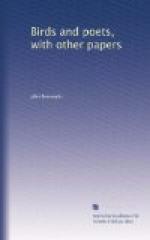The lark is a more marvelous songster than the bobolink only on account of his soaring flight and the sustained copiousness of his song. His note is rasping and harsh, in point of melody, when compared with the bobolink’s. When caged and near at hand, the lark’s song is positively disagreeable, it is so loud and full of sharp, aspirated sounds. But high in air above the broad downs, poured out without interruption for many minutes together, it is very agreeable.
The bird among us that is usually called a lark, namely, the meadowlark, but which our later classifiers say is no lark at all, has nearly the same quality of voice as the English skylark,—loud, piercing, z-z-ing; and during the mating season it frequently indulges while on the wing in a brief song that is quite lark-like. It is also a bird of the stubble, and one of the last to retreat on the approach of winter.
The habits of many of our birds are slowly undergoing a change. Their migrations are less marked. With the settlement and cultivation of the country, the means of subsistence of nearly every species are vastly increased. Insects are more numerous, and seeds of weeds and grasses more abundant. They become more and more domestic, like the English birds. The swallows have nearly all left their original abodes—hollow trees, and cliffs, and rocks—for human habitations and their environments. Where did the barn swallow nest before the country was settled? The chimney swallow nested in hollow trees, and, perhaps, occasionally resorts thither yet. But the chimney, notwithstanding the smoke, seems to suit his taste best. In the spring, before they have paired, I think these swallows sometimes pass the night in the woods, but not if an old, disused chimney is handy.
One evening in early May, my attention was arrested by a band of them containing several hundreds, perhaps a thousand, circling about near a large, tall, disused chimney in a secluded place in the country. They were very lively, and chippering, and diving in a most extraordinary manner. They formed a broad continuous circle many rods in diameter. Gradually the circle contracted and neared the chimney. Presently some of the birds as they came round began to dive toward it, and the chippering was more animated than ever. Then a few ventured in; in a moment more, the air at the mouth of the chimney was black with the stream of descending swallows. When the passage began to get crowded, the circle lifted and the rest of the birds continued their flight, giving those inside time to dispose of themselves. Then the influx began again, and was kept up till the crowd became too great, when it cleared as before. Thus by installments, or in layers, the swallows were packed into the chimney until the last one was stowed away. Passing by the place a few days afterward, I saw a board reaching from the roof of the building to the top of the chimney, and imagined some curious person or some predaceous boy had been up to take a peep inside, and see how so many swallows could dispose of themselves in such a space. It would have been an interesting spectacle to see them emerge from the chimney in the morning.




